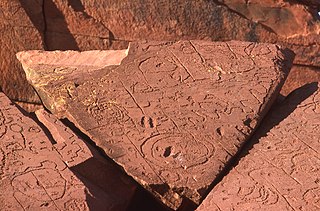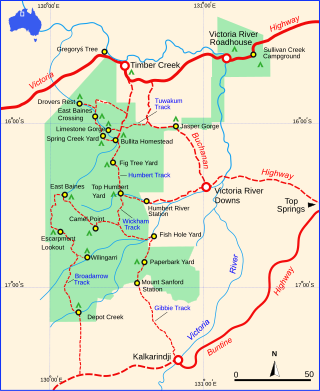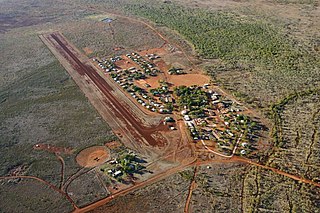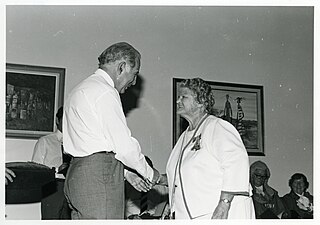
The Northern Territory is an Australian territory in the central and central northern regions of Australia. The Northern Territory shares its borders with Western Australia to the west, South Australia to the south, and Queensland to the east. To the north, the territory looks out to the Timor Sea, the Arafura Sea and the Gulf of Carpentaria, including Western New Guinea and other islands of the Indonesian archipelago.

The protected areas of the Northern Territory consists of protected areas managed by the governments of the Northern Territory and Australia and private organisations with a reported total area of 335,527 square kilometres (129,548 sq mi) being 24.8% of the total area of the Northern Territory of Australia.

Judbarra National Park, formerly Gregory National Park and Judbarra / Gregory National Park, is a national park in the Northern Territory of Australia, 359 km (223 mi) south of Darwin.

Katherine is a town in the Northern Territory of Australia. It is situated on the Katherine River, after which it is named, 320 kilometres (200 mi) southeast of Darwin. The fourth largest settlement in the Territory, it is known as the place where "The outback meets the tropics". Katherine had an urban population of approximately 6,300 at the 2016 Census.

Adansonia gregorii, commonly known as the boab and also known by a number of other names, is a tree in the family Malvaceae, endemic to the northern regions of Western Australia and the Northern Territory of Australia.

Sir Augustus Charles Gregory was an English-born Australian explorer and surveyor. Between 1846 and 1858 he undertook four major expeditions. He was the first Surveyor-General of Queensland. He was appointed a lifetime Member of the Queensland Legislative Council.

The Victoria Highway links the Great Northern Highway in Western Australia with the Stuart Highway in the Northern Territory. The highway is a part of the Perth–Darwin National Highway link. It is signed as National Highway 1, and is part of Highway 1, a circular route around the country. It is 555 kilometres (345 mi) long, and most of the route – some 470 kilometres (290 mi) – lies within the Northern Territory. In some areas it runs in parallel with the Northern Territory's Victoria River, from which its name originates.
The Northern Land Council (NLC) is a land council representing the Aboriginal peoples of the Top End of the Northern Territory of Australia, with its head office in Darwin.

The Victoria River is a river in the bioregion of Victoria Bonaparte in the Northern Territory of Australia. It flows for 560 kilometres (350 mi) from its source south of the Judbarra / Gregory National Park to the Joseph Bonaparte Gulf in the Timor Sea.

Daly River is a town adjacent to the Daly River in the Northern Territory of Australia. At the 2006 census, Daly River had a population of 468. The town is part of the Victoria Daly Region local government area. The area is popular for recreational fishing, being regarded as one of the best places to catch Barramundi in Australia.

Lajamanu, formerly known as Hooker Creek Native Settlement or just Hooker Creek, is a small town of the Northern Territory of Australia. It is located around 560 km (350 mi) from Katherine and approximately 890 km (550 mi) from Darwin. At the 2016 Australian census, Lajamanu had a population of 606, of whom 89.3 percent are of Aboriginal and/or Torres Strait Islander origin, chiefly Warlpiri people.
Jaminjung is a moribund Australian language spoken around the Victoria River in the Northern Territory of Australia. There seems to be a steady increase in the number of speakers of the language with very few people speaking the language in 1967, about 30 speakers in 1991, and between 50 and 150 speakers in 2000.

The Bradshaw Field Training Area (BFTA) is a large army training area located 600 km (370 mi) south of Darwin in the Northern Territory of Australia. It is used for training by the Australian Army as well as an as an Australia-U.S. combined training centre, with the U.S. Marines stationed at Darwin.
The Wickham River is an ephemeral river, located in the Victoria Bonaparte bioregion of the Northern Territory in Australia.

Ficus coronulata, commonly known as the peach-leaf fig, and in the Northern Territory as river fig and crown fig, is one of several fig species commonly known as sandpaper figs. It is native to Western Australia and the Northern Territory.
The Jamindjung, also spelt Djamindjung, are an indigenous Australian people of the Northern Territory.
The Ngaliwurru are an indigenous Australian people of the Northern Territory.

Northern Territory v Mr A. Griffiths (deceased) and Lorraine Jones on behalf of the Ngaliwurru and Nungali Peoples [2019] HCA 7 is an Australian native title court case that was heard in the High Court of Australia. This case was an appeal by the Northern Territory and the Commonwealth of Australia of the decision handed down by the Full Court of the Federal Court of Australia in Northern Territory of Australia v Griffiths [2017] FCAFC 106. The High Court of Australia ruled to reduce the amount of compensation awarded to the Ngaliwurru People and the Nungali People by the Full Court of the Federal Court of Australia. This compensation had been granted to the Ngaliwurru and Nungali Peoples as a remedy for deeds taken by the Northern Territory Government that were previously established by the judicial system to have extinguished native title. The total amount of compensation awarded was reduced from $2,899,446 to $2,530,350. This compensation had been awarded for the monetary and non-monetary loss, as well as interest, associated with the extinguishment of native title. The decision made by the High Court meant the appeals made by the Northern Territory and the Commonwealth were "allowed in part". The case of Northern Territory v Mr Griffiths and Lorraine Jones has been labelled one of the most significant native title court cases since Mabo v Queensland and Mabo v Queensland. The Ngaliwurru and Nungali Peoples reside in Timber Creek, Northern Territory. The High Court granted special leave for the appeal on 16 February 2018. The High Court, which is situated in Canberra, had not heard a case in the Northern Territory prior to this.
Baines is a locality in the Northern Territory of Australia located in the territory's west adjoining the border with the state of Western Australia about 421 kilometres (262 mi) south of the territory capital of Darwin and about 359 kilometres (223 mi) south-west of the municipal seat in Katherine.

Eileen Marjory Fitzer was an Australian nursing sister, political activist and NT pioneer.
















